





Published on Nov 30, 2023
In today's urban environment high rise buildings, parking areas, network of roads have acquired major urban land. In such congested environment rooftop and terrace of buildings provide a valuable potential source of outdoor space accessible to users of building. Need of terrace gardens has increased with increasing number of high rise buildings which deprive their occupants of any visual contact with nature. Terrace gardens bring back the missing link between man and nature though on a moderate scale. The factors which make roof gardens important part of architecture throughout the world is:-
• Full use of terrace, which is normally a discarded area in crowded cities. Maximum meaningful use of minimum available space.
• An economical way of balancing green space with uncontrolled growth of cement structure in urban areas.
•They provide additional insulation to building .
The trend of terrace garden is not new, for centuries it has been common to use rooftops as a living space/Recreational space. •The first known historical reference to a roof garden is the stone temples in the region of Mesopotamia . Civilizations in Mesopotamia built roof gardens thousands of years ago on the landings of Ziggurats, or stepped pyramids.

The next known successor to the roof gardens are the Hanging Gardens of Babylon built by the Persians around the 500 B.C . The roof gardens along with being a visual delight cooled the hot landscapes and provided greenery.
• To study and understand what is terrace garden and its need and utilization.
• To study its construction ,Impact on building , Elements involved in terrace garden and architectural aspects of terrace gardens.
• Case study and its analysis, Green roof- A case for Nagpur
This includes study of design of terrace garden, basic study of plant materials, structural implication and Construction techniques.
• Case specific- Restricted to study of residential and housing.
• The study is limited to Landscape elements and plants used (Detail of elements or plants won’t be studied)
• Restricted to climate of Nagpur only.
A terrace garden is a garden which is established on a terrace, roof, or patio, usually in a house where there is limited gardening space. These types of terrace gardens are especially popular in urban areas. (www.wisegeek.com)
• Terrace gardens are commonly created at three different levels, which are:
• On rooftop of a building.
• Porches, window boxes, portico , balconies and such projected levels out of tower block, above the ground level
• At the podium level, around the base or on roof of large basements.
• The introduction of vegetation/ greenery in the urban fabric may help to relieve the ill effects of Urban heat island effect, pollution, global warming etc.
• Green roofs – “Terrace Gardens” bring green spaces into urban areas while offering thermal benefits and energy savings for the user.
• A major reason for the neesd of the terrace garden is the contribution they make to the building insulation and energy savings.
•Planted roofs at the individual and the organizational level may become places of recreation.
•Terrace gardens used as organic farming unit.
There are two types of green roof systems, namely:
1.INTENSIVE (DEEP)
2.EXTENSIVE (SHALLOW)
• Thin growing medium; little or no irrigation; stressful conditions for plants; low plant diversity.
Overall depth:70-120mm
Weight max:80-125kg/sq.m
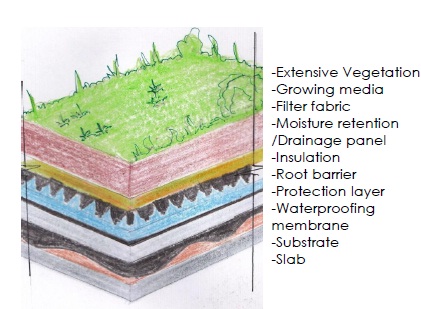
• Lightweight; roof generally does not require reinforcement.
• Suitable for large areas.
• Low maintenance and long life.
• Often no need for irrigation and specialized drainage systems.
• Often suitable for retrofit projects.
• Can leave vegetation to grow spontaneously.
• Relatively inexpensive.
• Looks more natural.
• Less energy efficiency and storm water retention benefits.
• More limited choice of plants.
• Unattractive to some, especially in winter.
• Deep soil; irrigation system; more favourable conditions for plants; high plant diversity; often accessible.
Overall depth:150-1500mm
Weight max:200kg/sq.m
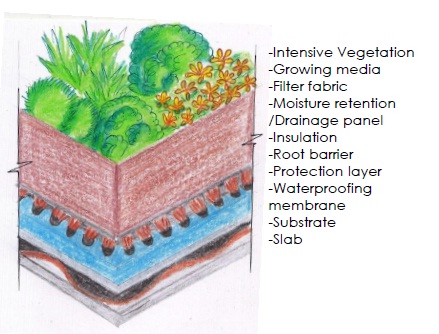
• Greater diversity of plants and habitats.
• Good insulation properties.
• Can be made very attractive visually.
• More diverse utilization of the roof. i.e. for recreation, growing food.
• More energy efficiency and storm water retention capability.
• Longer membrane life.
• Greater weight loading on roof.
• Need for irrigation and drainage systems requiring energy, water, materials.
• Higher capital & maintenance costs.
• Green roofs consist of both horticultural elements and traditional roofing components.
There are three distinct layers in a green roof from the bottom, namely:
1.Structural layer
2.Growing media
3.Vegitative layer
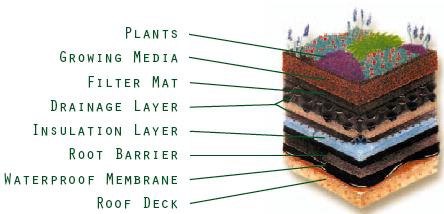
- The most important layer on a green roof is its decking, which can be concrete, wood, metal, plastic, gypsum or composite as it determines whether the structure is capable of taking the load of the green roof.
The primary purpose of waterproofing is to keep the unwanted moisture from rain and condensation away from the structure below.
The roof is the primary location for heat transfer and the insulation restricts the transfer of heat energy through the roof by creating a barrier between spaces of different temperature
As green roofs contain living and growing materials, a protection layer and a root barrier are one of the most important elements of the assembly . -As roots grow they can penetrate the waterproofing membrane and create leak locations. The root barrier placed above the membrane ensures that no roots pass through and harm the membrane . -A protection layer shields the waterproofing membrane from damage after it has been installed.
A drainage course allows moisture to move laterally through the green roof system. It prevents oversaturation, ensures root ventilation and provides additional space for the roots to grow . -It is a porous, continuous layer over the entire roof surface just above the concrete slab.
This layer separates the growing medium from the drainage layer and protects the medium from shifting and washing away. -It restricts the flow of fine soil particles and other contaminants while allowing water to pass through freely to avoid clogging.
-The urban heat island is the overheating of urban and suburban areas, relative to the surrounding countryside, due to Increased paved, built-over, and hard surface areas.
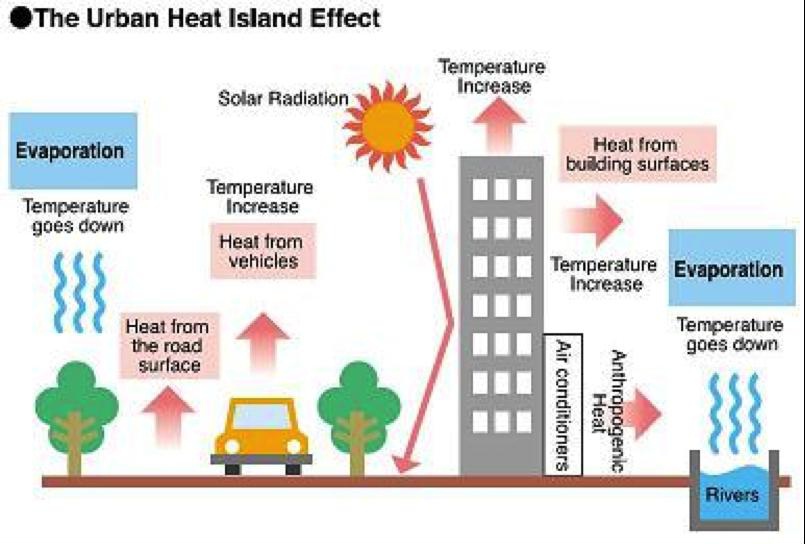
-As rooftops make up a significant percentage of the reflective non vegetated surfaces in the city.
-Introduction of greenery through green roofs in the urban areas can reduce impervious surfaces and soften streetscapes.
-Plants use heat energy for evapo-transpiration to achieve a cooling effect. By reducing the heat gain through the roof ambient temperature is lowered leading to less energy consumption
-Internal building temperature by 0.5˚C
-Reduces electricity consumption for air conditioning
Green roofs help to protect roofing membranes from extreme temperature fluctuations, the negative impact of ultraviolet radiation.
-green roofs can play an important role in providing recreational spaces in urban regions where there is little ground level green areas. As these spaces are visible from many vantage points, it adds to the visual character of the urban fabric.
The greater insulation offered by terrace garden can reduce the amount of energy needed in a building.
Roof surfaces offer the opportunity for growing food, particularly in high density urban areas where garden space may be limited . -food producing plants can substitute for ornamental plants in conventional roof gardens.
Green roofs filter out fine, airborne particulate matter as the air passes over the plants. Airborne particulates tend to get trapped in the surface areas of the greenery.
Hard surfaces of urban areas reflect sound and are unable to absorb it. Green roofs due to the vegetation absorb sound waves .
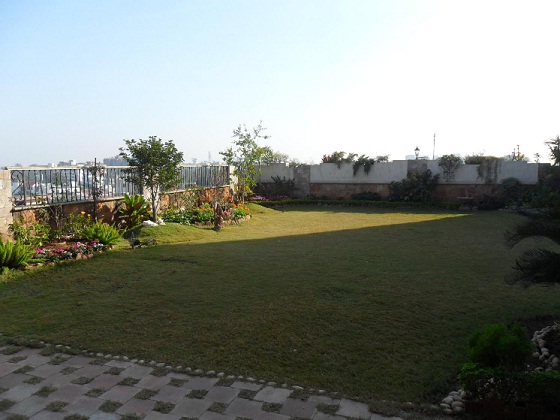
•The terrace garden is developed on the 6th floor.
•Approximate area of terrace garden is 200sq.m
•Garden developed is extensive type.
• Slab depth 600mm with waterproofing.
• Studying climate of Nagpur -Nagpur, which lies in composite climatic zone of India where maximum temperature is around 48˚C and minimum temperature is around 25˚C during sunshine hours.
• Construction material (if changes) -The construction material remains same which is used in any other part of India. The type may vary depending upon the slab/requirement of the user.
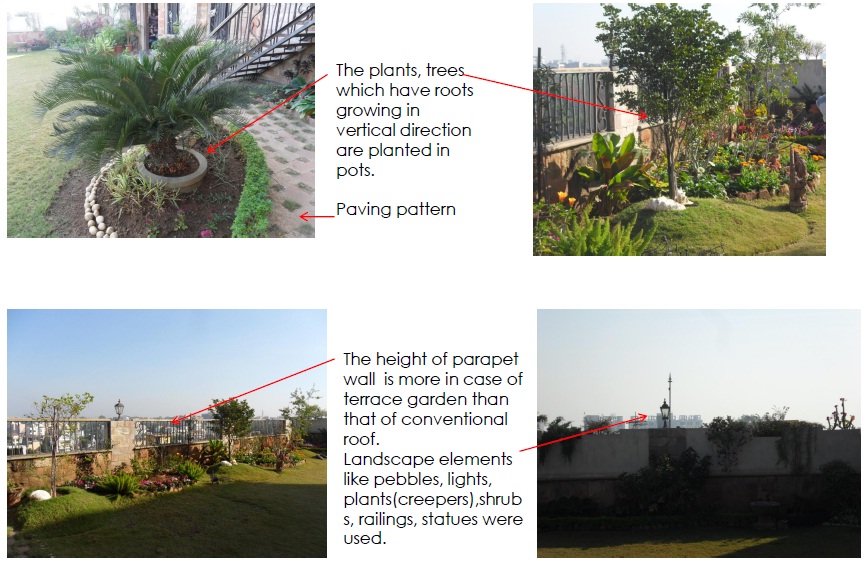
• Type of vegetation according to climate of Nagpur -The type of vegetation mainly depends upon the type of terrace garden which is to be developed (ex. Intensive or Extensive type). -The plants with roots growing in vertical direction or not recommended.
• Does Type (terrace garden) change according to building typology? -The type of terrace garden does not change according to the building typology. It changes as per the demand of the user. -In Nagpur where the temperature in summer is up to 48 degree, it is recommended to have more soil depth. The greater the soil depth, the better the plants are insulated from the high surface temperatures by the cooler soil below.
• Potential of terrace garden in residential building/ Bungalow.
-A terrace garden in a bungalow gives an opportunity of practicing organic farming .
-In Nagpur where the summers are extremely hot, terrace gardens reduce the interior temperature by 2 to 6 percent.
-It can be used as a recreational space.
-Reduction of energy consumption.
-Terrace gardens last longer than conventional roof.
As the world is heading towards the depletion of natural resources and the loss of forest/garden area due to urbanization, there is a dire need of terrace gardens. Due to the population explosion with a house for every citizen in the country, all the open areas are eaten away by concrete buildings. This has created the ecological imbalance, which can cause tremendous harm to our future generations. When we cannot avoid utilizing open spaces on the ground for the construction of buildings and other utilities, then at least the open spaces available above these buildings can be utilized for plantations and gardens to minimize the ecological imbalance, if not eliminate it altogether. There are many benefits of these terrace gardens, such as waste recycling, ecological benefits, energy conservation, water conservation, decorative enhancement of buildings, occupant’s health benefits and attracting birds and insects.
2. Green Roofs-United States EPA
3. Scholars Research Library-2012
4. Green Roofs-Wikipedia
5. BijliBachao Team-2015
6. Roof Garden Impact on Energy Savings -Patric Dixon
| Are you interested in this topic.Then visit the below page to get the full report |